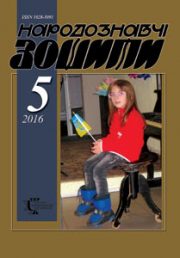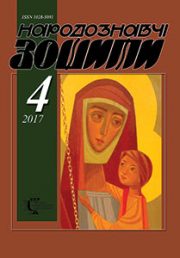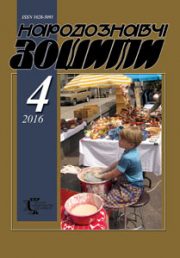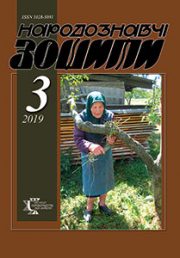The Ethnology Notebooks. 2021. № 3 (159), 581—592
UDK 94(47+57)”1932/1933″
DOI https://doi.org/10.15407/nz2021.03.581
BORIAK Tetiana
- ORCID ID: http://orcid.org/0000-0002-7472-0014
- Candidate of Sciences (History), Associate Professor,
- PhD student, History department
- Taras Shevchenko National University of Kyiv,
- 64/13, Volodymyrska Street, City of Kyiv, Ukraine, 01601
- Contacts: e-mail: tetiana.boriak@fulbrightmail.org
Abstract. From the end of the 1980-s, for more than ten years of intense Holodomor studies the researchers thought that total confiscation of grain resulted into extreme mortality — the Holodomor. Gradualy they had been coming to a conclusion that extortion of non-grain food reserves turned the famine into the Holodomor.
The goal of the research is to analyze confiscation of food reserves from Ukrainian peasants and Kuban stanychnyky through the prism of oral history sources during the Holodomor.
Methodological ground of the research is historical-comparative method.
The scientific novelty of the article. For the first time comparison of mechanism of turning of starvation into the Holodomor in UkrSSR and Kuban by confiscation of food reserves during household searches with usage of oral history sources only.
The result of the analysis is presented in 9 tables. They show types of food reserves, extorted by the authorities, as well as the facts of confiscation of home stuff and clothes. Quantitative and geographical parameters of analyzed sources that come from two regions indicate categorical superiority of Ukrainian data: 169 testimonies (99,4% out of general amount of involved into analysis oral history sources) against 105 testimonies (47,5%). Ukrainian data array of oral history sources looks in general more informative with data on the topic. This data array also allows stating that confiscation of food took place in much more amount of stanyts’, than officially was blacklisted. Similarity of categories of taken food allows to cautiously (to give more affirmative answer we need bigger amount of oral history sources on Kuban sample) assuming that Ukraine and Kuban had become one space where food was confiscated.
Practical significance of the research. Because of the lack of Kuban sources, the Ukrainian sources allow to rank the UkrSSR as a first-place region with total purposeful confiscation of food reserves among other grain regions of the USSR.
Keywords: oral history, famine of 1932—1932, Holodomor, Kuban, Ukraine, household searches, confiscation of food.
Received 22.05.2021
REFERENCES
- Kul’chitskii, S. (2007). Why did he kill us?: Stalin and Ukrainian Golodomor. Kyiv: Ukrajins’ka pres-grupa [in Russian].
- Kul’chytskyi, S., & Boriak, T. (Ed.). (2016). Foreword by an editor. In T. Boriak. 1933: «Why are you still alive?» (Pp. 7—18). Kyiv: Klio [in Ukrainian].
- Kul’chytskyi, S. (2007). Holodomor 1932—1933 on Kuban’. Ukraine of XXth c.: culture, ideology, politycs: Col. of art. (Issue 12, pp. 88—101). Retrieved from: http://dspace.nbuv.gov.ua/bitstream/handle/123456789/77638/07-Kulchytskyi.pdf?sequence=1 [in Ukrainian].
- Veselova, O., Nikiliev, O., & Smolii, O. (Eds.). (2009). Foreword: Genocide of Ukrainian people through the prism of archival data, testimonies of those who survived and eyewitnesses. Memory of the people: genocide in Ukraine with hunger of 1932—1933. Testimonies (Book 1, (pp. 7—33). Kyiv: Kalyta [in Ukrainian].
- Veselova, O., & Yukhnovskyi, I. (Ed.). (2009). Testimonies of 1932—1933 famine-genocide eyewitnesses in Ukraine as a source of study of its reasons and consequences. Holodomor 1932—1933 in Ukraine: the reasons, demographic consequences, legal evaluation» (Kyiv, September 25—26, 2008) (Proceedings of the International research conference) (Pp. 189—210). Kyiv: Kyiv-Mohyla akademy [in Ukrainian].
- Kapustian, H., & Yukhnovskyi, I. (Ed.). (2009). Evaluation of Holodomor 1932—1933 in Ukraine in oral history documents. Holodomor 1932—1933 in Ukraine: the reasons, demographic consequences, legal evaluation» (Kyiv, September 25—26, 2008) (Proceedings of the International research conference) (Pp. 169—188). Kyiv: Kyiv-Mohyla academy [in Ukrainian].
- Kapustian, H. (2008). «Memory of 33-rd calls youth» (scientific-research project of students of Kremenchuk state politekhnichal university named after Mykhailo Ostrohrads’ky. Problems of history of Ukraine: facts, opinions, searches. To 75-th anniversary of famine-genocide 1932—1933 in Ukraine (Issue 18, pp. 437—448) [in Ukrainian].
- Boriak, T. (Ed.). (2016). Svidchennia. 1933: «Why are you still alive?» (Pp. 128—673). Kyiv: Klio [in Ukrainian].
- Boriak, T. (Ed.). (2016). Holodomor everyday life: a list of main terms met in the texts, to name realities, actors and actions. 1933: «Why are you still alive?» (Pp. 677—687). Kyiv: Klio [in Ukrainain].
- Boriak, T. (2013). Confiscation of non-grain reserves as beginning of Holodomor: official documents vs survivors testimonies. Research Papers of the International Association of Ukrainian Studies (Issue 6, pp. 256—271) [in Ukrainain].
- Oskolkov, E. (1991). Grain procurements and famine 1932/ 1933 in Northern-Caucasian region. Rostov: izd-vo Rostovskogo universiteta [in Russian].
- Kondrashin, V. (2008). Famine 1932—1933: tragedy of Russian village. Moscow: ROSSPEN [in Russian].
- Vasilev, I., Zudin, A., Bondar, N., & Matveev, O. (Eds.). (2009). «Golodomor» on Kuban’ of 1932—1933 in historical memory of survivors: review essay. Historical memory of South of Ruthenian population about the famine of 1932—1933 (Proceedings of Scientific-Practical Conference) (Pp. 184—195). Krasnodar: Plekhanovets [in Russian].
- Korsakova, N., Bondar, N., & Matveev, O. (Eds.). (2009). Famine of 1932—1933 on Kuban’ in memoirs of old residents. Historical memory of South of Ruthenian population about the famine of 1932—1933 (Proceedings of Scientific-Practical Conference) (Pp. 208—213). Krasnodar: Plekhanovets [in Russian].
- Matveev, O., Bondar, N., & Matveev, O. (Eds.). (2009). Methodological aspekts of famine 1932—1933 oral history on Kuban. Historical memory of South of Russian population about the famine of 1932—1933 (Proceedings of Scientific-Practical Conference) (Pp. 19—32). Krasnodar: Plekhanovets [in Russian].
- Boriak, T. (2020). Famine 1932—1933 in historical memory: Ukraine vs Russia (reflections over oral history sources). Ukrainian historical journal (Issue 5, pp. 176—189). Retrieved from: https://doi.org/10.15407/uhj2020.05.176 [in Ukrainian].
- Papakin, H. (2013). «Black board»: anti-peasant repressions (1932—1933). Kyiv: Institute of history of Ukraine [in Ukrainian].
- Bondar, N., & Matveev, O. (Eds.). (2009). Famine on Kuban: 1932—1933. Field materials of Kuban folklore-ethnografic expedition of Scientific-research center of traditional culture of GNTU «Kuban cossack choir». Historical memory of South of Ruthenian population about the famine of 1932—1933 (Proceedings of Scientific-Practical Conference) (Pp. 336—442). Krasnodar: Plekhanovets [in Russian].
- State statistics service of Ukraine. Amount of administrative-territorial units in regions of Ukraine by January 1st, 2017 (data from official web-portal of Verkhovna Rada Ukrainy). Retrieved from:
- http://www.ukrstat.gov.ua/operativ/operativ2016/ds/ator/ator2017_u.htm (Last accessed: 20.05.2021) [in Ukrainian].
- Barka, V. (2002). Kuban holokaust. Rodnaia Kuban. Literaturno-istoricheskii zhurnal, 3, 62—68 [in Russian].
- Rakachev, V., Bondar, N., & Matveev, O. (Eds.). (2009). State politics of grain procurements of 1932—1933 on Kuban and its demographic consequences. Historical memory of South of Ruthenian population about the famine of 1932—1933 (Proceedings of Scientific-Practical Conference) (Pp. 129—140). Krasnodar: Plekhanovets [in Russain].
- Andriunkin, P. (2002). People died like flies. Rodnaia Kuban. Literaturno-istoricheskii zhurnal, 3, 130 [in Russain].
- Vlaskina, T., Bondar, N., & Matveev, O. (Eds.). (2009). Famine on Don in oral history. Historical memory of South of Russian population about the famine of 1932—1933 (Proceedings of Scientific-Practical Conference) (Pp. 155—174). Krasnodar: Plekhanovets [in Russian].
- Gritsenko, A. (2002). It nowhere to go from it!… Rodnaia Kuban. Literaturno-istoricheskii zhurnal, 3, 129—130 [in Russian].
- Eremeeva, A., Bondar, N., & Matveev, O. (Eds.). (2009). Famine on Kuban in memory of Kuban researcher V.F. Pisarenko. Historical memory of South of Ruthenian population about the famine of 1932—1933 (Proceedings of Scientific-Practical Conference) (Pp. 216—219). Krasnodar: Plekhanovets [in Russian].
- Litovka, P. (2002). Sabotage. Rodnaia Kuban. Literaturno-istoricheskii zhurnal, 3, 127—129 [in Russian].
- Alekseenko, I. (2002). Punishment with famine. Rodnaia Kuban. Literaturno-istoricheskii zhurnal, 3, 33—36 [in Russian].
- Makarenko, P. (2002). Death is called 33-rd. Rodnaia Kuban. Literaturno-istoricheskii zhurnal, 3, 14—25 [in Russian].







